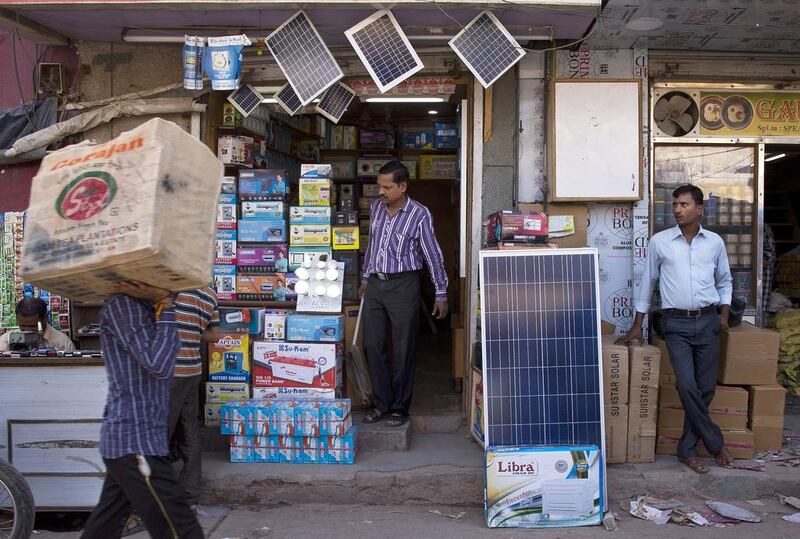NEW DELHI // Two months before a key United Nations summit on climate change, India has pledged to cut fossil fuel emissions and develop renewable energy sources.
While the plan is considered conservative, analysts said its submission was a significant triumph. The conference will be held in Paris from November 30 to December 11.
India, the world’s third-largest carbon polluter, submitted its plan on October 1 to reduce carbon emissions intensity by 33 to 35 per cent by 2030, from 2005 levels.
The next day, environment minister Prakash Javadekar outlined the objectives in a 40-page document, calling India’s goals “comprehensive, progressive and ambitious”.
Emissions intensity is the ratio of fossil fuel emissions to the country’s gross domestic product. According to the plan’s outline, India’s emissions, in absolute terms, will continue to grow – carbon emissions will still have tripled from 2005 to 2030.
However, as the economy expands, India’s emissions per unit of economic output will fall.
Without this plan, India’s carbon emissions would have been on track to increase seven-fold, instead of threefold, from 2005 to 2030.
Unlike other major polluters such as the United States and the European Union, India has not committed to absolute reductions in emission levels.
According to the proposal, India also aims to draw about 40 per cent of its electricity from wind, solar, hydroelectric and nuclear energy by 2030.
“Our every action will be cleaner than what it was earlier,” Mr Javadekar said. “I am positive that we will become a part of the solution. We will produce results.”
India’s two-pronged approach has been met with approval in several quarters.
Rhea Suh, president of the National Resources Defence Council (NRDC), a non-profit organisation based in New York, called the plan strong and comprehensive.
India’s commitment “to renewable energy will pave the way to sustainable economic growth that creates jobs, protects natural resources, and provides cleaner air and water for Indian citizens”, Ms Suh said.
However, some analysts in India have been more circumspect in their commendation.
The contrast with other countries is stark.
By 2030, the US has pledged to cut absolute carbon dioxide emissions, rather than only emissions intensity levels, by 32 per cent from 2005 levels. China has promised a cut in emissions intensity by 60 to 65 per cent, while Brazil plans to reduce emissions by 37 per cent by 2025, from 2005 levels. The EU has committed to reducing overall emissions to at least 40 per cent below 1990 levels by 2030.
India’s long-held position in climate negotiations has been that its primary objective is to lift millions of its citizens out of poverty, and that it cannot afford to scale back economic development to cut emissions.
Using the metric of emissions intensity, rather than targeting cuts in absolute emission levels, will allow India to promote economic development and mitigate the effects of climate change, said Radhika Khosla, a researcher at the Centre for Policy Research, a New Delhi-based think tank.
“By this measure, the emissions intensity target is conservative when compared with recent Indian modelling studies, and roughly consistent with India’s Cancun pledge for 2020,” Ms Khosla said.
At the Cancun climate change conference in 2010, India had promised to cut emissions intensity by 20 to 25 per cent of 2005 levels by 2020.
“The other energy target, of 40 per cent fossil fuel-free electricity capacity by 2030, will likely lead to substantial renewable energy development.”
Vinuta Gopal, one of the two interim executive directors at Greenpeace India, called India’s plan “a step in the right direction”.
“It certainly puts India in a good position to play a strong role in Paris,” she said of the conference.
But “India is at the same time planning to more than double its coal energy”, Ms Gopal said.
“This will set back India’s development prospects, by worsening problems of air quality and water scarcity, as well as contributing to the destruction of forests from mining, and displacement of communities.”
India’s proposal includes plans to increase forest cover across the country, to help absorb carbon dioxide emissions, and to adapt development programmes in sectors that are vulnerable to climate change, such as agriculture and water resource policy.
Ms Gopal said, however, that the government has shown “no recognition of the importance of protecting existing forests”.
Overall, she said, the plan was cautious.
“It is clear that India doesn’t want to be seen as blocking progress on a global agreement, but will wait to see the developed world do more before it commits to a more ambitious transition,” she said. ssubramanian@thenational.ae





